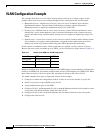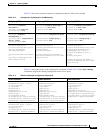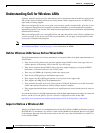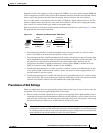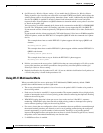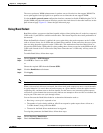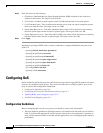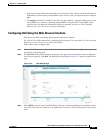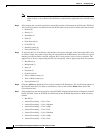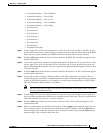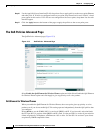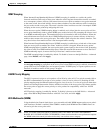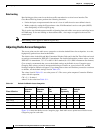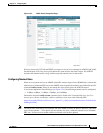
15-6
Cisco IOS Software Configuration Guide for Cisco Aironet Access Points
OL-30644-01
Chapter 15 Configuring QoS
Configuring QoS
Step 3 Enter the values for the following:
• Client-Rssi—Minimum Receive Signal Strength Indicator (RSSI) required for the client to be
eligible for band select. The range is from 20 to 90.
• Cycle-Count—Number of probe requests on the 2.4 GHz band that the access point ignores.
• Cycle-Threshold (ms)—Time in milliseconds that the access point can expect each probe request
burst cycle from the client. The range is from 1 to 1000.
• Expire-Dual-Band (secs)—Time after which dual-band clients will be declared as new and may
have their probe request frames delayed or ignored again. The range is from 10 to 300.
• Expire-Suppression (secs)—Time after which 2.4 GHz-only clients will be declared as new and may
have their probe frames delayed or ignored again. The range is from 10 to 200.
Step 4 Click Apply.
Beginning in privileged EXEC mode, use these commands to configure BandSelect using the access
point CLI:
- ap(config)# dot11 band-select parameters
- ap(config-bs-profile)# cycle-count?
- ap(config-bs-profile)# cycle-threshold?
- ap(config-bs-profile)# expire-suppression?
- ap(config-bs-profile)# expire-dual-band?
- ap(config-bs-profile)# client-rssi?
- ap (config)# dot11 ssid abcd
- ap(config-ssid)# band-select
Configuring QoS
QoS is disabled by default (however, the radio interface always honors tagged 802.1P packets even when
you have not configured a QoS policy). This section describes how to configure QoS on your access
point. It contains this configuration information:
• Configuration Guidelines, page 15-6
• Configuring QoS Using the Web-Browser Interface, page 15-7
• Adjusting Radio Access Categories, page 15-12
• AVVID Priority Mapping, page 15-11
Configuration Guidelines
Before configuring QoS on your access point, you should be aware of this information:
• The most important guideline in QoS deployment is to be familiar with the traffic on your wireless
LAN. If you know the applications used by wireless client devices, the applications’ sensitivity to
delay, and the amount of traffic associated with the applications, you can configure QoS to improve
performance.



